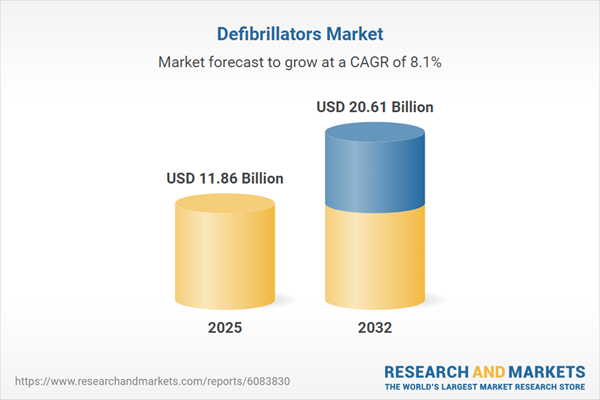Speak directly to the analyst to clarify any post sales queries you may have.
The defibrillators market is experiencing significant transformation, driven by healthcare innovation, evolving emergency care protocols, and expanding digital health infrastructure. For senior decision-makers navigating complex procurement, compliance, and technology priorities, understanding the current landscape and future shifts is essential for sustained competitive advantage.
Market Snapshot: Growth Trajectory and Defibrillators Market Overview
The defibrillators market grew from USD 11.01 billion in 2024 to USD 11.86 billion in 2025. It is forecast to continue expanding at a compound annual growth rate (CAGR) of 8.14%, with revenues projected to reach USD 20.61 billion by 2032. Growth is supported by heightened adoption in both clinical and non-clinical settings, ongoing innovation in connectivity features, and a rise in demand for life-saving cardiac emergency interventions globally.
Scope & Segmentation: Exploring the Defibrillators Market Landscape
- Device Types: Automated External Defibrillators (AED), Manual External Defibrillators, Wearable Cardioverter Defibrillators, Implantable Cardioverter Defibrillators (Dual-Chamber, Single-Chamber, Subcutaneous ICDs)
- Technology: Biphasic Technology, Monophasic Technology
- Patient Types: Adult Patients, Pediatric Patients
- End Users: Hospitals, Pre-Hospital Care Providers, Public & Community Access
- Supply Channels: Offline Retail, Online Platforms
- Key Regions: Americas (United States, Canada, Mexico, Brazil, Argentina, Chile, Colombia, Peru), Europe Middle East & Africa (United Kingdom, Germany, France, Russia, Italy, Spain, Netherlands, Sweden, Poland, Switzerland, United Arab Emirates, Saudi Arabia, Qatar, Turkey, Israel, South Africa, Nigeria, Egypt, Kenya), Asia-Pacific (China, India, Japan, Australia, South Korea, Indonesia, Thailand, Malaysia, Singapore, Taiwan)
- Leading Companies: Abbott Laboratories, AMI Italia S.r.l., OIARSO S COOP, Biotronik SE & CoKG, Boston Scientific Corporation, CU Medical Systems, Inc., GE HealthCare Technologies Inc., Koninklijke Philips N.V., Mediana Co., Ltd., Medtonic PLC, Metsis Medikal, MicroPort Scientific Corporation, Narang Medical Limited, Nihon Kohden Corporation, Progetti Srl, Schiller AG, Shenzhen Mindray Bio-Medical Electronics Co., Ltd., Stryker Corporation, Thermo Fisher Scientific Inc., ZOLL Medical Corporation by Asahi Kasei Corporation, Avive Solutions Inc., Weinmann Emergency Medical Technology GmbH + Co. KG
Key Takeaways for Senior Decision-Makers
- Technological innovation, including device portability and advanced energy delivery, is expanding use beyond traditional hospital environments.
- Growth in wearable and implantable defibrillators is contributing to new patient management models and improving therapy precision.
- Integration of digital platforms and analytics is modernizing device monitoring and enabling real-time emergency response coordination.
- Segments such as public access and pre-hospital care are accelerating market penetration, especially as community-based programs broaden reach to nontraditional venues.
- Collaboration between manufacturers, logistics providers, and digital health startups is optimizing distribution strategies in mature and emerging markets.
- Regulatory and reimbursement trends are shaping company strategies, highlighting the need for agile response to policy changes and evolving data-driven requirements.
Tariff Impact: Navigating US 2025 Duties on Defibrillators
Forthcoming United States tariffs in 2025 are expected to exert upward pressure on defibrillator manufacturing costs, global supply chains, and cross-border trade. Device makers are actively exploring local production, nearshoring, and multi-sourcing strategies to maintain supply continuity and manage cost volatility. Healthcare providers and payers must adjust capital planning and reimbursement models in response to anticipated price fluctuations.
Methodology & Data Sources
This analysis utilizes primary interviews with clinicians, healthcare executives, and medtech industry experts, combined with secondary research from regulatory filings, trade data, and peer-reviewed studies. Segmentation, scenario planning, and sensitivity assessments ensure rigorous evaluation of market and tariff impacts. Findings undergo validation via external expert reviews and real-world observational audits.
Why This Report Matters
- Delivers actionable insight into the evolving defibrillators market landscape, enabling better resource allocation and procurement strategy alignment.
- Empowers leaders to address regulatory, technological, and competitive challenges with targeted, data-driven guidance unique to each major region.
- Facilitates proactive scenario planning and risk mitigation for upcoming regulatory changes and global supply chain fluctuations.
Conclusion
This report provides strategic clarity for stakeholders seeking to navigate the dynamic defibrillators market. Emphasis on innovation, segmentation, and evolving policy environments equips leaders to optimize adoption pathways and support measurable improvements in cardiac emergency response outcomes.
Table of Contents
3. Executive Summary
4. Market Overview
7. Cumulative Impact of Artificial Intelligence 2025
Companies Mentioned
The companies profiled in this Defibrillators market report include:- Abbott Laboratories
- AMI Italia S.r.l.
- OIARSO S COOP
- Biotronik SE & CoKG
- Boston Scientific Corporation
- CU Medical Systems, Inc.
- GE HealthCare Technologies Inc.
- Koninklijke Philips N.V.
- Mediana Co., Ltd.
- Medtonic PLC
- Metsis Medikal
- MicroPort Scientific Corporation
- Narang Medical Limited
- Nihon Kohden Corporation
- Progetti Srl
- Schiller AG
- Shenzhen Mindray Bio-Medical Electronics Co., Ltd.
- Stryker Corporation
- Thermo Fisher Scientific Inc.
- ZOLL Medical Corporation by Asahi Kasei Corporation
- Avive Solutions Inc.
- Weinmann Emergency Medical Technology GmbH + Co. KG
Table Information
| Report Attribute | Details |
|---|---|
| No. of Pages | 186 |
| Published | November 2025 |
| Forecast Period | 2025 - 2032 |
| Estimated Market Value ( USD | $ 11.86 Billion |
| Forecasted Market Value ( USD | $ 20.61 Billion |
| Compound Annual Growth Rate | 8.1% |
| Regions Covered | Global |
| No. of Companies Mentioned | 23 |









